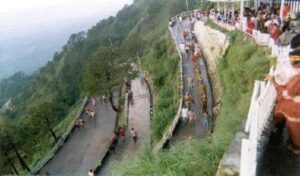
The Trikuta hills, popularly known as Vaishno Devi hills, constitute a part of the outermost hills of Jammu Shivaliks. It lies at a distance of 48 km from Jammu city which is the winter capital of Jammu and Kashmir State. Trikuta is a three peaked mountain.
Trikuta is one of the twenty mountains surrounding Maha-Meru. The height is said in the Bhagavata Purana to be 10,000 yojanas, and the three peaks are iron, silver and gold. The mountain is believed to be the second home of the divine goddess Durga. She was created with the power of the three goddesses to end evil; hence, the mountain is called Trikuta.
The Trikuta hills are characterised by a highly mountainous terrain, the tract being quite rugged and cut into deep gorges and high ridges. The hills suddenly emerge from the Katra valley, situated at an altitude of 750m above mean sea level on the north bank of Banganga river.
They arise steeply up to Surajkund above Bhairon Ghatti (2167m amsl). The area drains into the river Chenab through two perennial streams, namely, Banganga and Pei Nallah. These hills harbour a very rich avian and mammalian fauna.
Vaishno Devi, a holy cave shrine situated at an altitude of over 5000 feet in a beautiful recess of the Trikuta mountains forming a part of the lower Himalayas attracts a huge number of pilgrims every day of the year unless the route is blocked by snowfall. Within the cave are ancient images of three deities, Mahakali, Mahalakshmi and Mahasaraswati. Popular belief holds that anybody who walks up to the shrine of Vaishno Devi to ask for a boon rarely goes back disappointed. There are many who journey here year after year to pay obeisance, regardless of their faith or belief, creed or class, caste or religion, for Mata Vaishno Devi transcends all such barriers.
Source:


